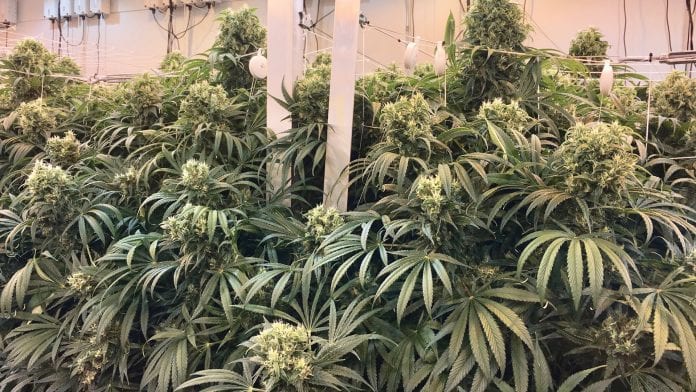
Joe Bender of Cannabis Crop Solutions LLC talks us through maximising growth and yields of cannabis crop production.
Although often considered a weed, cannabis has many needs that growers must accommodate. Watering, fertilisation, light levels, carbon dioxide, and temperature, amongst many other factors, all have an impact on crop performance. When developing an overall plan for a garden, some growers might not consider that many individual factors, like each of those previously mentioned, could be the limiting factor in the performance of their cannabis crop production.
What is a limiting factor?
A limiting factor is a factor associated with crop growth that is not being properly supplied or controlled and is thereby preventing the crop from meeting its genetic growth potential. Increasing other inputs, or improving other environmental conditions, will not benefit the crop until the limiting factor is properly addressed.
For example, if the crop is grown in conditions that are too cool plant metabolism will be slow, so augmenting the carbon dioxide level will have little to no benefit. As another example, if a crop is deficient in copper then providing more nitrogen will not improve growth until the copper deficiency is corrected.
I like to use a barrel to diagram this concept. The rungs of the barrel don’t represent relative quantities; a full-length rung represents the optimum amount of each nutrient, however little or much that might be. As you can see, the barrel couldn’t hold more water by raising just the nitrogen (N) level, although it could hold more water by raising just the copper (Cu) level. The barrel could hold the most water (i.e. the plant could perform best) by increasing the supply of both Cu and N to optimal levels. Look at all aspects of your production system when determining limiting factors. Whether it’s an input, or an environmental parameter, determining what is limiting your crop is essential for improving crop performance.
Luxury consumption: satisfying the needs of multiple strains
If you’ve grown more than one strain of cannabis, then you have probably noticed that different strains have different fertilisation requirements for optimal growth and development. One strain might show signs of calcium deficiency (yellowing of the tips of the newest leaves), while another strain fertilised the same way seems to flourish. The demand for other nutrients can likewise differ from strain to strain, which can make growing multiple strains seem formidable.
Luckily, with some trial and error, you can create a fertilisation plan that satisfies the nutrient requirements of all of your strains, by supplying a concentration of each essential nutrient that is well within the luxury consumption range (see graph below). Luxury consumption is when a plant is getting more of a nutrient (or multiple nutrients) than it needs, but not enough to cause it harm – thereby allowing it to reach 100% of its growth potential or yield (assuming all other needs such as light are supplied adequately). This is the area on the graph where the performance of the strains level off at 100%.
Increasing nutrient concentrations or fertilisation can enhance growth rates and yields, until the concentration reaches the luxury consumption range; at which point greater concentrations don’t boost either metric. At some point however, elevated nutrient concentrations can be toxic to a plant causing fertiliser burn or other harm, as represented by the downward curves on the graph.
Of the three hypothetical strains, ‘A’ needs the least nutrients for optimal growth and is also the most sensitive to high nutrient levels. ‘B’ needs slightly more nutrients than ‘A,’ and ‘C’ represents a strain that is pickier than either of the other two, with a narrower range of suitable fertilisation. Even with a picky strain in the mix, you can still create a fertiliser plan that is suitable for all of your plants. The bright green line on the graph highlights the overlap within the luxury consumption range of all three strains. This overlap portrays the range of nutrient concentrations or fertilisation rates that a grower should target.
The graph could represent concentrations or rates of a well-balanced, complete fertiliser, or a single essential element such as nitrogen. Bear in mind that as previously discussed, any one element could be a limiting factor, so you’ll need to supply the elements in proper ratios, in order to develop a nutrition plan suitable for all your plants. Nutrient per-acre quantity recommendations for seed hemp, from university and government extension services, are a good starting point when establishing a nutrition plan.
These recommendations can be converted to per-cubic foot quantities for growing in pots. This can be an especially effective way of quantifying organic nutrient inputs, where EC measurements aren’t applicable. Please see Cannabis Crop Solutions, LLC’s December 2018 newsletter (in the website’s newsletter archive at www.cannabiscropsolutions.net/newsletter-archive), for detailed information regarding nutrient calculations. Carefully observe your plants reactions to various application rates and use these observations along with yield data to determine optimal nutrient levels.
Sea of green, screen of green, monster plants, and in-between
I’m often asked the question “how much do you yield per plant?” I always answer that aside from the genetic potential of each strain, it depends on how big I grow the plants. As growers know, Cannabis is considered a short-day flowering plant, because it will only flower when it receives 12 hours of light or less per day. This means that you can elongate the length of the vegetative period (prior to flowering) indefinitely, by providing more than 12 hours of light — most commonly 18 hours of light and 6 hours of darkness. Doing so will allow you to grow cannabis plants as big as you prefer. Growers tend to develop a preference for small, medium, or large plants, depending on their overall strategy for production, whether they are growing indoors or outdoors, and whether local laws restrict their plant count.
There are advantages and disadvantages to each size of plant, and several different training techniques can be used. When growers root clones and then immediately place them under 12 hours of light to keep them as small as possible, they are using the ‘sea of green’ technique. Vegging plants for an extended period and weaving them through a horizontal trellis is known as the ‘screen of green’ technique, which can be used to grow medium to very large plants. Plants can also be topped to make them bushier, or left un topped to produce a dominant cola, and vegetated for a couple of weeks to a few months, to develop medium to monster-sized plants.
The biggest advantage of the sea of green technique is a fast turnaround time for each crop. Forgoing the vegetative stage means as rapid of a production cycle as possible. This could help increase annual yields and reduce the time that pests and pathogens have to multiply on a crop should they find their way into your garden. Individual plants are also easy to harvest and move if necessary, with each plant typically only requiring one stake to support its single dominant shoot. The need for stakes can be eliminated at the expense of a loss of mobility, by allowing the plants to grow through a horizontal trellis for support.
Another plus of sea of green is that with proper pruning and adequate spacing, bud quality can be quite uniform throughout the crop. Lower axillary shoots should be removed, leaving the shoots subtending fan leaves to produce photosynthate for the main cola. Proper spacing (in this case close spacing) will have the physiological effect of discouraging branching, and encouraging competition amongst individual plants, thereby promoting dominance of each plant’s central cola. Be sure not to cramp plants too much, which will increase the risk of powdery mildew.
The biggest disadvantage of the sea of green style is the large number of plants needed to populate your flowering space. For example, with just a couple of weeks of vegetation 4 plants will completely fill in a 4 x 4 space; that same space would require about 16 to 25 plants in a sea of green scenario. This large difference in plant count may be legally restrictive and will also require at least 4 times more clonal propagation. Extra propagation requires more space for mother plants, more space for clones to root, and more labour. For most growers, extra propagation space means less area will be available for flowering, which you should factor in when estimating potential yearly yields.
Screen of green (SCROG) is a popular technique for home growers with relatively small gardens and can also be used in commercial production. However, it doesn’t work with all varieties of cannabis. Plants that are too woody will not bend easily enough to weave them through the horizontal trellis and will quickly grow up through it despite your best efforts.
Afghani plants and auto flowering plants with compact growth habits are also incompatible with SCROG. Vigorously growing hybrids are best suited for this technique, especially those that are naturally branchy and lanky. Secure your trellis about 6 inches or so above newly planted clones, and then top the clones to help them branch out. As the axillary shoots elongate, tuck their tips under the nearest lines of trellis netting, spreading them in a radial fashion outwardly from the plants.
Continue this training until the trellis is well-occupied by branches. Bear in mind that the plants will continue to vegetate and will even accelerate their rate of vegetative growth through the transition phase, which occurs during the first two weeks of the 12/12 light cycle, so don’t over-veg them.
When this training is done correctly, many colas will erupt out of the trellis as flowering continues, creating short, wide plants. This is very advantageous where height is limiting, such as in closet grows and other stealthy growth chambers. It also allows you to grow relatively large plants that are quite short, which can help when you’re legally restricted to a limited number of plants. Having to weave the plants through the trellis is the biggest downside of SCROG, as it is labour-intensive. The effort needed shouldn’t be prohibitive to most home growers, but in commercial production the extra labour cost should be considered.
Growing massive, ‘monster’ plants is common in outdoor and greenhouse cultivation, and some indoor growers also fancy the method. Plants grow rapidly in natural sunlight. Sunlight also penetrates large canopies more efficiently than artificial lighting, due to its intensity and the movement of the sun across the sky. This promotes branching, thereby stimulating plants to form a large, spherical shape. If you’re planting outdoors where you can’t control the light cycle, early spring planting will provide enough time for plants to naturally become monstrous. Box shaped trellising can help accommodate such plants, preventing wind damage and the need for excessive, laborious staking/ tying of branches.
West coast outdoor growers in North America prefer to grow large plants, which can each yield 5 pounds or more (of dried cannabis). Indoor growers in British Columbia also prefer to grow large plants. They often use 50-gallon trash cans for pots, and space the pots about 3 to 5 feet apart in a honey-comb-like layout, with vertically oriented, reflectorless HID lights hanging between plants. The plants are commonly supported with a single, large central stake with strings arranged in a conical fashion tied to branches.
A balance between the advantages and disadvantages of the aforementioned techniques can be struck by growing medium sized plants, using trellises for support. It’s helpful to use at least two layers of horizontal trellising, spaced about 1.5 to 2 feet apart. Some side branches won’t reach the upper trellis, but the lower trellis will keep them upright as they gain weight. Following rooting and transplanting, veg your plants for 1.5 to 3 weeks, depending on the growth rate of your strains, and the desired final plant size.
Such plants will need approximately four-square feet of space. Because plant growth is exponential over time, a little patience in the vegetative stage goes a long way in reducing the needed number of clones for a full canopy, thereby reducing the amount of space you’ll need to dedicate to mother plants and to rooting clones – and will also cut down on cloning labour.
Although the crop will spend a little more time in the vegetative stage, posing a longer risk of pest and disease problems, organic pesticides can be sprayed preventatively on vegetating plants, without compromising flower quality or consumer safety. ‘Beneficials’ such as predatory mites, entomopathogenic nematodes, predatory insects, and fungicidal beneficial microbes like Bacillus subtilis and Trichoderma harzianum, are also useful tools for preventing pest and disease infestations and should be considered for any growing style.
Understanding the ups and downs of different plant sizes, and methods of growing cannabis plants will help you to determine the best fit for your needs. When deciding on a cultivation strategy, weigh in the type of growing environment, the number of crop cycles per year, allocation of your garden space, pest and disease risks, plant count legality, and labour costs.
About Cannabis Crop Solutions
Cannabis Crop Solutions, LLC will provide your company full spectrum insight into the big picture of the cannabis industry. Founding scientist Joe Bender specialises in crop consulting, but his diverse knowledge of all things cannabis will empower your company to take a holistic approach to decision making. He will shed light on the pros and cons of various paths you may consider, and optimise the harmonious functioning of your operations.
Examples of services provided by Cannabis Crop Solutions, LLC:
- Guidance and writing for competitive cannabis licence application processes;
- Planning and design of greenhouses, indoor cultivation facilities, breeding rooms, and tissue culture labs;
- Assistance with selecting affordable HPLC equipment, and establishing in-house potency testing;
- Commercial scale irrigation and hydroponic system design;
- Improving management protocols for optimal crop performance;
- Cultivation problem solving, and resolution of pest and disease issues;
- Short-term and long-term retainer arrangements, for consultation as needed.
Potential projects are provided a custom-tailored, detailed proposal, featuring a situation appraisal, project objectives, timing, and options for implementation.
Please visit www.cannabiscropsolutions.net for more information, and to subscribe to the monthly newsletter.
About the author
Bender is an independent crop consultant with his company Cannabis Crop Solutions, LLC. He earned his B.S. in horticultural science from the University of Florida in December of 2009, before starting his first consulting company based in Summit County, Colorado. There he helped growers overcome pest and disease problems, improved crop quality, and even discovered a light cycle interruption was the cause of a crop disorder. He also wrote an article on integrated pest management of thrips, for High Times’ July 2011 issue.
After meticulously planning the cultivation operation for Breakwater Treatment and Wellness in Cranbury, New Jersey he became their head grower in August of 2014. Having established Breakwater’s reputation for the highest quality cannabis flowers in NJ, Joe left to return home in October 2018, to Orlando, FL, and started Cannabis Crop Solutions, LLC.
His cultivation articles have recently been published in Cannabis Culture, Weed World, and High Times. He also has a new cultivation column in The Evolution, a Kansas City, Missouri based cannabis magazine. Joe is an expert cannabis grower, horticulturalist, plant pathologist, and entomologist, and is well versed in tissue culture, facility automation, cannabis pharmacology, ingestion and inhalation methods, extraction techniques, cannabis manufacturing, potency testing, and cannabis history. He enjoys golf, guitar, skateboarding, surfing, snowskating, and the company of friends and family.
To contact Cannabis Crop Solutions, LLC email joe@cannabiscropsolutions.net, or call
+1 (321) 217 7730.
Joe Bender
Consultant and President
Cannabis Crop Solutions, LLC
+1 321 217 7730
joe@cannabiscropsolutions.net
www.cannabiscropsolutions.net/
This article will appear in Health Europa Quarterly Issue 11, which is available to read now.



















